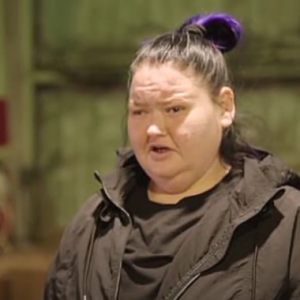The Hidden Chaos Behind the Heartwarming facade of the Slaton Family
Watching “1000-Lb Sisters” is much like holding a backstage pass into a rollercoaster of emotion, tension, humor, and heartbreak. Beneath the surface of the family’s seemingly humorous and relatable moments lies a complex web of unspoken expectations, blurred boundaries, and deeply ingrained trauma. The Slaton family’s story is a raw, unfiltered glimpse into a family that has survived poverty, neglect, and trauma but now struggles to find their footing in a world that demands independence and self-care. Their closeness—once a source of comfort—is now an emotional battleground, threatening to unravel the fragile threads that hold them together.
At the heart of their chaos are Tammy and Amy, two sisters whose bond is as fierce as it is destructive. Their relationship embodies the intense codependency that often characterizes families with unresolved trauma. Amy, the older sister, bears the heaviest burden—primarily because she loves Tammy unconditionally but often at the expense of her own well-being. Her relentless efforts to help Tammy lose weight and improve her life are commendable but sometimes veer into enabling. Tammy, for her part, leans heavily on Amy for emotional and physical support, refusing to step out of the cocoon of dependence. Their dynamic is a relentless tug-of-war—each feeling responsible for the other’s success or failure, weighed down by guilt and buried resentment.
This web of emotional enmeshment isn’t limited to the sisters alone. Their brother, Chris, a supportive and lovable figure, tries to mediate and support from the sidelines. Yet even his well-meaning efforts illustrate how blurred boundaries have become in this household. His tough love, intended to motivate Tammy, often pushes her further into dependency, raising the question: When does support become enablement? The family’s roles fluidly shift from caregivers to targets of criticism, as everyone seems ensnared in this web of overinvolvement. This hyper-involvement amplifies the chaos, making it nearly impossible for any individual to experience personal growth or independence.
Perhaps most disturbing is the family’s collective inability to recognize or respect personal space—both emotional and physical. Amy’s exhaustion from balancing her newborn’s needs with her sister’s demands epitomizes this dilemma. She loves Tammy deeply but also recognizes that true help requires setting limits—yet doing so risks rejection and familial estrangement in a culture that equates closeness with unconditional love. Tammy’s journey to accept support, whether through rehab or therapy, increasingly highlights this tension: she thrives when given space, but the fear of abandonment keeps her tethered to her family’s dysfunctional mold. The family’s narrative is a tragic reminder that survival in a trauma-filled environment is not the same as thriving, and breaking free from these chains demands immense courage. 
What would it take for the Slaton family to heal? The answer lies in redefining boundaries—not as betrayal or rejection but as acts of love and respect. True boundaries could enable Amy to prioritize her own health and happiness, allow Tammy to work on her independence, and give Chris room to support without overstepping. Therapy—both individual and family—is an essential part of this process, addressing the deep-rooted wounds behind the surface issues of weight and conflict. It’s about acknowledging that support does not mean sacrifice, and strength isn’t measured by how much one can carry; rather, it’s about knowing when to let go and allow each member to stand on their own. Only then can they begin to transform their relational chaos into a foundation for genuine healing.
Ultimately, the story of the Slaton family is a poignant reflection on the importance of boundaries in achieving emotional well-being. Their resilience is undeniable—they’ve survived trauma that many would not have endured. But survival is only the first step. To truly thrive, they need to embrace the difficult act of letting go—throwing up guard rails to protect their mental health, even if that means risking disappointment or family discord. Love, in their context, isn’t necessarily proximity; it’s respect for each other’s space and individuality. Their journey is a powerful testimony that sometimes, the most profound act of love is simply stepping back, setting boundaries, and trusting that love can endure even when it’s delivered from a distance. If they can learn this, perhaps the chaos will give way to clarity, and the closeness that once charmed them will become the healthy intimacy that sustains them.





